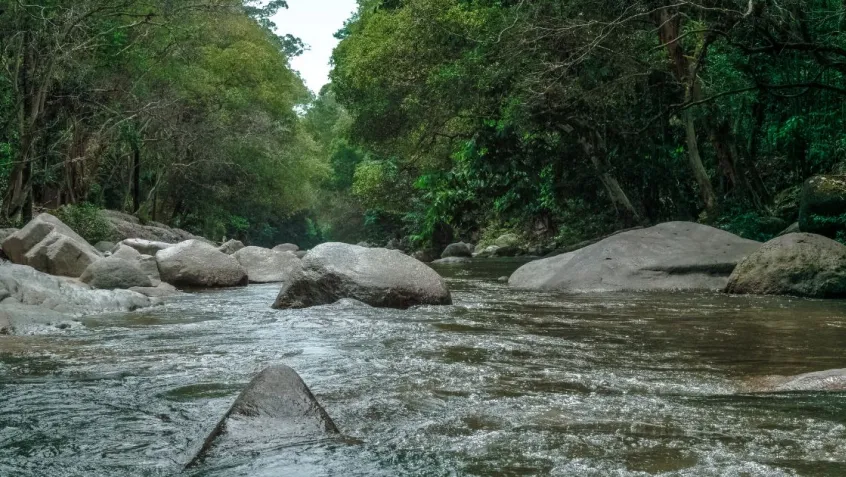Skip to main content
Lesson One: Watershed Basics
American Rivers. n.d. “America’s Rivers.” Accessed July 12, 2016. http://americanrivers.org/rivers/
American Rivers. n.d. “Conserving Clean Water.” Accessed July 12, 2016. https://www.americanrivers.org/threats-solutions/clean-water/
Great Lakes Environmental Research Laboratory. n.d. “About Our Lakes: Ecology.” NOAA. Accessed July 12, 2016. http://www.glerl.noaa.gov/education/ourlakes/ecology.html
Great Lakes Environmental Research Laboratory. n.d. “About Our Great Lakes: Great Lakes Basin Facts.” NOAA. Accessed July 12, 2016. http://www.glerl.noaa.gov/pr/ourlakes/facts.html
Hyndman, Donald, and David Hyndman. 2011. “Sinkholes, Land Subsidence, and Swelling Soils.” In Natural Hazards and Disasters , 3rd ed., 235-259. Canada: Brooks-Cole, Cengage Learning.
Maupin, Molly A., Joan F. Kenny, Susan S. Hutson, John K. Lovelace, Nancy L. Barber, and Kristin S. Linsey. 2014. Estimated Use of Water in the United States in 2010. US Geological Survey Circular 1405. Reston, VA: USGS. http://dx.doi.org/10.3133/cir1405
National Geographic. n.d. “Encyclopedic Entry: Estuary.” Accessed July 12, 2016. http://nationalgeographic.org/encyclopedia/estuary/
National Park Service. n.d. “Mississippi River Facts.” US DOI. Accessed July 12, 2016. https://www.nps.gov/miss/riverfacts.htm
National Wild and Scenic Rivers System. n.d. “River and Water Facts.” US Bureau of Land Management, National Park Service, US Fish and Wildlife Service, and US Forest Service. Accessed July 12, 2016. https://www.rivers.gov/waterfacts.php
Smith, Thomas M., and Robert L. Smith. 2009. “Aquatic Ecosystems.” In Elements of Ecology , edited by Beth Wilbur, 7th edition, 523-524. San Francisco, CA: Pearson Benjamin Cummings.
Texas Transportation Institute. 2007. Waterways: Working for America; Highlights of “A Modal Comparison of Freight Transportation Effects on the General Public,” a study by the Texas Transportation Institute, Texas A&M University. Texas A&M University. http://www.marad.dot.gov/wp-content/uploads/pdf/water_works_REV.pdf
US Census Bureau. 2012. “Geography: State Area Measurements and Internal Point Coordinates.” Accessed July 12, 2016. http://www.census.gov/geo/reference/state-area.html
US DOI. n.d. Restoring the Great Lakes: DOI Stories of Success and Partnership in Implementing the Great Lakes Restoration Initiative . http://pubs.usgs.gov/unnumbered/70048731/report.pdf
US EPA. 2016. “Climate Change: Northeast.” Accessed July 12. https://www3.epa.gov/climatechange/impacts/northeast.html
US EPA. 2016. “Drinking Water in New England: Water Conservation Tips for Residents.” Accessed July 12. https://www3.epa.gov/region1/eco/drinkwater/water_conservation_residents.html
US EPA. 2016. “Nutrient Pollutant Discharge Elimination System (NPDES): Combined Sewer Overflow Frequent Questions.” Accessed July 12. https://www.epa.gov/npdes/combined-sewer-overflow-frequent-questions
US EPA. 2016. “National Pollutant Discharge Elimination System (NPDES): NPDES Stormwater Program.” Accessed July 12. https://www.epa.gov/npdes/npdes-stormwater-program
US EPA. 2016. “Nutrient Pollution: Harmful Algal Blooms.” Accessed July 12. https://www.epa.gov/nutrientpollution/harmful-algal-blooms
US EPA. 2016. “Nutrient Pollution: What You Can Do.” Accessed July 12. https://www.epa.gov/nutrientpollution/what-you-can-do
US EPA. 2016. “Nutrient Pollution: What You Can Do; In Your Home.” Accessed July 12. https://www.epa.gov/nutrientpollution/what-you-can-do-your-home
US EPA. 2016. “Nutrient Pollution: What You Can Do; In Your Yard.” Accessed July 12. https://www.epa.gov/nutrientpollution/what-you-can-do-your-yard
US EPA. n.d. “EPA’s Report on the Environment: Ground Water.” Accessed July 12, 2016. https://cfpub.epa.gov/roe/chapter/water/ground.cfm
USGS. 2001. A Primer on Water Quality. FS-027-01. Reston, VA: US DOI. http://pubs.usgs.gov/fs/fs-027-01/pdf/FS-027-01.pdf
USGS. 2016. “Aquifers and Groundwater.” US DOI. Accessed July 12. http://water.usgs.gov/edu/earthgwaquifer.html
USGS. 2016. “Groundwater: What is Groundwater?” US DOI. Accessed July 12. http://water.usgs.gov/edu/earthgw.html
USGS. 2016. “Groundwater Depletion.” US DOI. Accessed July 12. http://water.usgs.gov/edu/gwdepletion.html
USGS. 2016. “Groundwater: Wells.” US DOI. Accessed July 12. http://water.usgs.gov/edu/earthgwwells.html
USGS. 2016. “Land Subsidence.” US DOI. Accessed July 12. http://water.usgs.gov/edu/earthgwlandsubside.html
USGS. 2016. “What is a Watershed?” US DOI. Accessed July 12. http://water.usgs.gov/edu/watershed.html
USGS. 2016. “The World’s Water.” US DOI. Accessed July 12. http://water.usgs.gov/edu/earthwherewater.html
Welsch, David J. 1991. Riparian Forest Buffers: Function and Design for Protection and Enhancement of Water Resources . NA-PR-07-91. Radnor, PA: USDA. Retrieved from: https://books.google.com/books?hl=en&lr=&id=rpSNdMJz4XQC&oi=fnd&pg=PP3&dq=headwater+streams+as+drinking+water+sources&ots=76YEPnMaVR&sig=wY3-DB4k1IZU7tlpe87f2O3P0bo#v=onepage&q&f=false
Lesson Two: Protect Water Quality at Home
Boone County Regional Sewer District. 2016. “Stuff We Can’t Treat.” Accessed July 19. http://www.bcrsd.com/site/index.php?option=com_content&view=article&id=44&Itemid=46 .
Department of Ecology. 2016. “What You Can Do… Car Washing.” State of Washington. Accessed July 19. http://www.ecy.wa.gov/washington_waters/carwash.html
Dias, Mara. 2015. “How Does Conserving Water Help Protect Clean Water at the Beach?” Surfrider Foundation. Accessed July 19, 2016. http://www.surfrider.org/coastal-blog/entry/how-does-conserving-water-help-protect-clean-water-at-the-beach
Mannino, Vince, Robert Richter, Doug Welsh, and Sam Cotner. 2015. "Don't Bag It – Leaf Management Plan." Texas A&M AgriLife Extension, Earth-Kind Landscaping. Accessed September 16. http://aggie-horticulture.tamu.edu/earthkind/landscape/leaf-management-plan/ .
Maupin, Molly A., Joan F. Kenny, Susan S. Hutson, John K. Lovelace, Nancy L. Barber, and Kristin S. Linsey. 2014. Estimated Use of Water in the United States in 2010. US Geological Survey Circular 1405. Reston, VA: USGS. http://dx.doi.org/10.3133/cir1405 .
Princeton Environmental Commission. 2015. “Princeton’s Guide to Fall Leaf Management.” Municipality of Princeton. http://www.princetontwp.org/PEC_leafBrochure.pdf .
US EPA. 2015. “Stormwater Pollution Prevention for Small Residential Construction Sites.” EPA 830-F-15-001. US EPA. https://www.epa.gov/sites/production/files/2015-12/documents/cgp_small_lot_swppp_brochure-508_0.pdf .
US EPA. 2016. “Household Hazardous Waste.” Accessed July 19. https://www.epa.gov/hw/household-hazardous-waste-hhw .
US EPA. 2016. “Learn About the Safer Choice Label.” Accessed July 19. https://www.epa.gov/saferchoice/learn-about-safer-choice-label .
US EPA. 2016. “The Sources and Solutions: In and Around the Home.” Accessed July 19. https://www.epa.gov/nutrientpollution/sources-and-solutions-and-around-home .
US EPA. 2016. “What You Can Do: In Your Yard.” Accessed July 19. https://www.epa.gov/nutrientpollution/what-you-can-do-your-yard .
USGS. 2013. “Land Subsidence.” Accessed July 19, 2016. http://water.usgs.gov/ogw/subsidence.html .
USGS. 2016. “Groundwater Depletion.” Accessed July 19. http://water.usgs.gov/edu/gwdepletion.html .
USGS. 2016. “Thermoelectric Power Water Use.” Accessed July 19. http://water.usgs.gov/edu/wupt.html .
USGS. 2016. “Wastewater Treatment Water Use.” Accessed July 19. http://water.usgs.gov/edu/wuww.html
USGS. 2016. “Water Questions & Answers: Where Does Our Home Wastewater Go?” Accessed July 19. http://water.usgs.gov/edu/qa-home-wastewater.html
WaterSense. 2016. “Fix a Leak Week.” US EPA. Accessed July 19. https://www3.epa.gov/watersense/pubs/fixleak.html .
WaterSense. 2016. “Indoor Water Use In the United States.” US EPA. Accessed July 19. https://www3.epa.gov/watersense/pubs/indoor.html .
WaterSense. 2016. “Outdoor Water Use in the United States.” US EPA. Accessed July 19. https://www3.epa.gov/watersense/pubs/outdoor.html .
WaterSense. 2016. “Showerheads.” US EPA. Accessed July 19. https://www3.epa.gov/watersense/products/showerheads.html .
WaterSense. 2016. “Start Saving.” US EPA. Accessed July 19. https://www3.epa.gov/watersense/our_water/start_saving.html .
WaterSense. 2016. “Toilets.” US EPA. Accessed July 19. https://www3.epa.gov/watersense/products/toilets.html .
WaterSense. 2016. “The WaterSense Label.” US EPA. Accessed July 19. https://www3.epa.gov/watersense/about_us/watersense_label.html .
WaterSense. 2016. “WaterSense Labeled Irrigation Controllers.” US EPA. Accessed July 19. https://www3.epa.gov/watersense/products/controltech.html .
WaterSense. 2016. “Water Use Today.” US EPA. Accessed July 19. https://www3.epa.gov/watersense/our_water/water_use_today.html
WaterSense. 2016. “When It’s Hot.” US EPA. Accessed July 19. https://www3.epa.gov/watersense/our_water/when_its_hot.html .
Lesson Three: Water Quality in Your Community
